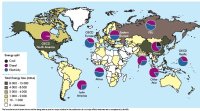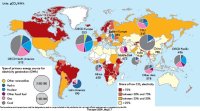In an article called a Path to Sustainable Energy by 2030 published in Scientific American this November the authors show how wind, water and solar technologies can provide all of the world’s energy, eliminating all fossil fuels.
Railway companies use large quantities of energy. Some companies generate their own energy and almost all railways organisations have the power to influence their energy mix due to being major purchasers of energy. In some countries it is also possible to opt for a ’green’ tariff or supply, directly influencing how their energy is generated.
While changing the source of energy to renewables is a crucial component of meeting CO2 emission reduction targets, there are also other technical and social changes that reduce energy demand.
During our journey from Kyoto to Copenhagen we were interested to learn first hand about the energy mix used by the different rail companies and their strategies for reducing dependence on fossil fuels. We were also interested in learning about technological innovations and the strategies being used to persuade transport users to shift mode to railway use.
Our enquiries were structured to some extent by the recent report commissioned and published by UIC, Keeping Climate Change Solutions on Track: The Role of Rail to inform the COP 15* process.
This report objective is to identify the emission reduction potential of rail for society. It discusses amongst other factors investment, modal shift, and energy efficiency. It also sets out how the railway sector can create a sound basis for decision-making by demonstrating a process for analysing the carbon use embedded within transportation.
In Japan rail is electrified. Electricity is provided by a single state-based supplier and currently around 15% of Japans electricity comes from renewables and nuclear power.
Russian railways is also electrified. During a meeting we had in Russia, the sustainability manager for the central Siberian railways in Irkutsk, we learnt that this region of Russian railways gets it’s energy from hydro power.
We were told that this region gets all its power from hydro-electricity and as this is their sole supply of energy so the regions railways already have a low carbon footprint. Her greatest environmental concern was rather to see through a regional programme of investment in water purification to deal with the waste-water produced when train-tankers and other equipment are cleaned.
Internationally, strategies for increasing the energy efficiency of rail can be categorised. Electrification is the most important category and a recent analysis from the International Energy Authority shows there is still some way to go towards a goal of 100% electrification of the world’s railways.
Electrification offers reductions in emissions over diesel-powered trains when the electricity is sourced from sustainable energy supplies, globally however there are significant differences in moves to renewable energy supply. The impact of increasing renewable energy sources in electricity generation on rail emissions can be clearly shown.
Swedish Rail, Statens järnvägars (SJ), which operates only electrically powered trains have taken the step of purchasing 100% renewable energy from hydroelectric and wind-powered sources. The positive impact on emissions reductions is illustrated by the journey between Stockholm and Gothenburg, on which an SJ train can carry up to 300 passengers and now emits only 400g of CO2, compared to a previous average of 44.5kg “ a reduction of over 99%.
In Spain, the rail operator Renfe is the biggest consumer of electricity, and increasing the percentage of renewable energy in the national energy mix from 18% to 31% contributed to a 43% reduction in CO2 emissions per Kwh in the operation of the rail sector.
1990-2008 Renfe reduced its total CO2 emissions by 33% and estimates it will decrease emissions further, 57% by 2020 based on 1990. Alongside the reductions in CO2 emissions, Renfe increased the amount of rail traffic by 19%, illustrating that greater mobility can be attained with less CO2 emissions.
After electrification train design offers the greatest opportunity to reduce the amount of energy used per passenger. High speed rail has been criticised in some quarters for using more energy than conventional rolling stock but in fact one of key feature of high speed rail is state-of-the-art train design that increases passenger carrying capacity and reduces the carbon footprint on a per passenger basis.
In France for example, the double-deck, double-unit TGV Duplex train offers 1090 seats in twenty vehicles compared to the 439 seats in the nine cars of a Pendolino train. Modern trains also often use regenerative braking. Here, when the trains brake, the electric traction motors become generators, converting the energy of the slowing train into usable power. The power generated as a braking current can then be fed back to the third rail, overhead line or returned to an electricity supplier. In the United States, Amtrak introduced Acela Express high speed trains and other new and remanufactured electric locomotives in 2006. These trains use regenerative braking systems and have allowed Amtrak to reduce energy consumption by 8% while in the UK Pendolino trains return 17% to the grid.
Reinforcing the potential role of new high speed trains in meeting energy reduction targets, in Sweden, the "Gröna Tåget! research estimated using regenerative braking results in more than 20% energy regeneration on existing lines and in the order of 30% on the planned high-speed lines.
This article was written en route to the UN Climate Conference in Copenhagen. The scientists have told the world community of the requirement for a reduction in current greenhouse gas emissions of 90% by 2050. A Path to Sustainable Energy by 2030 and many similar articles have clearly demonstrated that the energy production system can be de-carbonised. The railways are showing that they are part of a carbon free transport system and play a key role in this new world.
Now it is up to the decision makers in Copenhagen. We wish them the very best in their endeavours to produce a new climate treaty.
* The 15th meeting of the Conference of Parties (COP 15), the members of the UN Framework Convention on Climate Change (UNFCCC)

